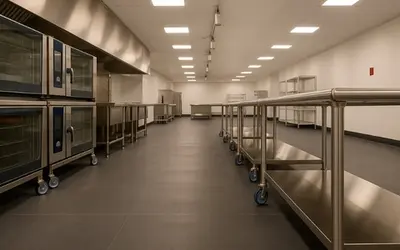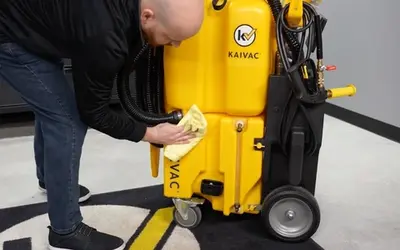Restaurant Floor Cleaning Made Easy

Restaurant floor cleaning is not as simple as it sounds. Not only are there greasy messes, drink spills and food stains to deal with, but designers often carve out restaurant zones by specifying different flooring materials. This means there could be carpet in the front of the house, wood flooring in the bar, sealed concrete in the dining area and a tile and grout commercial kitchen floor with ceramic tile.
Does your staff know how to maintain each material properly?
Getting it wrong can damage expensive finishes, devastate your reputation and hurt the bottom line. Fortunately, Kaivac has the right equipment, tools and techniques to make restaurant floor cleaning fast, complete and easy.
Read on for a list of common restaurant flooring types and cleaning methods.
How to Clean Restaurant Carpet
Designed to stand up to heavy traffic and tough stains, restaurant carpet lends a touch of luxury to a dining area. The material feels great underfoot, adds traction and offers acoustical dampening. Follow these tips to keep the material looking great season after season.
- Spot clean spills immediately: Accidents happen, but ignoring drinks spilled on carpet is a big mistake. Yes, industrial carpet is designed to repel liquids but an unattended spill will eventually soak in and leave a stain.
- Pick up crumby, solid messes: Messy eaters, think babies, can leave a trail of crumbs in their wake. Clean those crumbs up to avoid tracking the mess throughout the space and grinding food solids into carpet fiber.
- Vacuum carpets daily or more: A very busy dining room may need vacuuming several times a day to keep carpet looking fresh. Choose off times to vacuum the whole carpeted space.
- Deep clean and degrease: Grease removal is vital for restaurant carpet maintenance. Set up a schedule for deep cleaning that includes a strategy for removing grease. Chose a professional service or invest in an in-house Kaivac No-Touch Cleaning system paired with a carpet extraction wand to remove grease and soils at a much lower cost.
Tips to Clean Concrete Floors
A darling of designers looking to make a statement, sealed concrete checks a lot of boxes. It’s on trend, low cost, highly durable and can be painted, stained and textured for a unique look. Sealed concrete even works well in restaurant kitchens as it can be installed tight to the drains and up the walls to form a cove base.
To clean concrete floors, use the Kaivac Dispense-and-Vac. This system cleans up to 60 times better than mopping. Simply vacuum loose soils, apply a degreaser, let it dwell and vacuum up. Floors will be clean, grease free and dry.
Ceramic Tile Cleaning Made Easy
Ceramic tile and grout are a restaurant mainstay, and for good reason. The combination is highly durable, offers great traction and performance and is easy to maintain. A seemingly endless variety of colors and sizes means tile and grout floors can be found throughout the restaurant space, from the front entryway to the dining room and especially in the kitchen and restroom.
Cleaning tile and grout looks easy but beware—grout is quite porous and will absorb dirt, grease and pathogens. Cleaning with a mop and bucket makes the problem worse as the tile acts like a tiny squeegee, drawing dirty water out of the mop and depositing it on the porous grout. The result is dirty tile held together with discolored, malodorous grout. Sound appetizing?
Kaivac Univac wet-vac system is a better choice for tile floors than any mop and bucket. This technology applies cleaning solution evenly over the entire floor and has a brush wand for scrubbing grout lines. A wet vac removes the all of the dirt, soils and cleaning solution leaving tile and grout floors clean, dry and ready for work.
Restaurant floor cleaning is necessary but it doesn’t have to be hard, even if that floor is made up of several different materials. Contact Kaivac if you’re ready for tools and technology that leaves every surface clean, dry and ready to use.
Related Posts

Floor Cleanliness and Food Safety Scores
Poorly maintained floors are unsafe and unsanitary. They hold standing water, harbor pests, and cause slip, trip, and fall accidents. Here’s how to improve floor care and your food safety scores.
Read more
Preventive Maintenance for Your No-Touch Cleaning® System
Your Kaivac No-Touch Cleaning system makes restroom maintenance fast and easy. Keeping your No-Touch Cleaning system in good working order is also fast and easy. Kaivac makes performing preventative maintenance and troubleshooting potential issues simple. No special equipment or technical expertise required.
Read more
Beyond the Restroom: Kaivac for Fast, Easy, and Complete Kitchen Floor Care
You already know and trust Kaivac for restroom care. Our No-Touch Cleaning® systems make the unpleasant task of servicing restrooms fast, easy and complete. But did you know Kaivac has cleaning machines for every kind of floor?
Read more